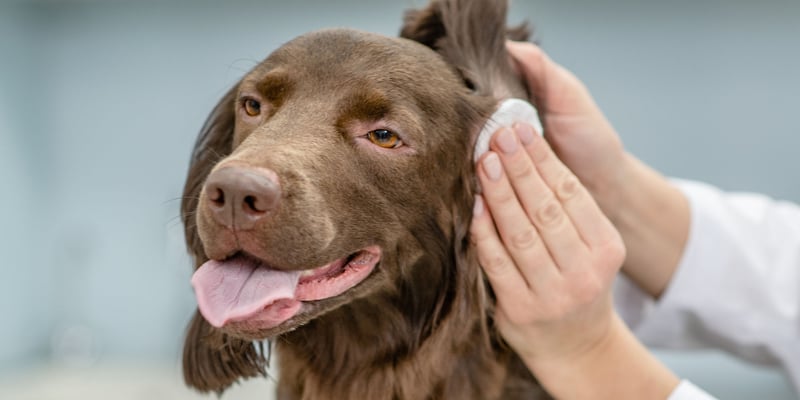Ear Mites in Dogs - Treatments and Symptoms of Ear Mites
Index:



Introduction
Have you noticed your dog itching and scratching their ears a lot? Perhaps they’re shaking their head more than usual and their ears have become inflamed? We don’t want alarm bells to sound but this could be a sign of ear mite infestation.
Fear not, as Waggel is here to help you understand more about ear mites in dogs and how you can rid your furry friend of these pesky little parasites for good. In this article, we touch upon what ear mites in dogs are as well as treatments and symptoms to look out for.
So, take a deep breath, grab a cup of tea - skip that step if that’s not your thing - and let’s begin.
What are ear mites in dogs?



Whilst they may sound big and scary, ear mites are actually microscopic in size meaning you won’t usually be able to see the little creatures with the naked eye. Phew.
They are, however, infectious and contagious causing distress to your playful pup. Ear mites usually reside in the skin of the ear canal, feeding off skin oils and ear wax. Not our idea of a tasty snack, that’s for sure.
Mites are arthropods and are closely related to spiders, both belonging to the arachnid family.
Adult ear mites usually live for around two months but multiply very quickly. Ear mite eggs take just four days to hatch and an additional three weeks to grow into an adult. With such a rapid growth rate, it’s no wonder they cause stress and upset for dog owners.
Ear mites look like tiiiiny little white dots. However, most people are unable to spot them at all. The usual telltale signs of ear mites in dogs are itching, scratching, and discharge from the ear which indicates a problem.
Under a microscope, ear mites resemble nasty brown bugs, hence why they leave dark discharge in the ears of dogs.
Ear mites can be more difficult to spot on dogs with luscious locks such as Afghan Hounds and Pekingese. Sometimes all that hair can make it tricky to take a look.
Can dog ear mites spread to humans?
As they’re contagious, it’s completely normal to question if humans can catch ear mites from dogs. To answer this, it’s best to answer where dogs catch ear mites from first!
Dogs catch ear mites through close contact with another dog or animal that has them. However, it’s not uncommon for dogs to also catch them by sharing contaminated items such as toys, food bowls, and bedding.
The good news is that humans are very unlikely to catch ear mites from dogs. Don’t celebrate too early though as humans can still be affected by mange which is a skin condition dogs can develop when mites are left untreated. Trust us when we say, this is very unpleasant!
If you have noticed signs of ear mites in your beloved pooch, we recommend seeking immediate veterinary assistance to prevent any further illness.



What are the symptoms of ear mites in dogs?
As ear mites are so small to the human eye, it can be very tricky to identify the critters. Instead, you may notice many ear mite-related symptoms. Let’s take a look at the common signs in closer detail, shall we?
Intense itchiness - this can also lead to head tilting and shaking.
Scratching more than usual - scratching can cause the area to become severely inflamed and irritated.
Dark discharge coming from the ears - this discharge is often compared to coffee grounds, though we must remind you it is definitely not the same thing.
Secondary skin infection - ear mites can cause skin infections all over the body most notably around the neck and rump.
Small bumps around the ears, neck, and tail - as mentioned above, ear mite infections aren’t just limited to the ears meaning your dog can also develop small bumps over their body.
Smelly ears - noticed your furry friend is leaving a bit of a stench around the house? Whilst you might just dismiss this as ‘dog smell’, it could be a sign of something more serious.
As you can see, the symptoms of ear mites aren’t solely limited to the ears. Ear mites are a very uncomfortable and, often, painful condition for dogs which is why it is important to take the necessary steps to treat them as soon as possible.
What is the treatment for ear mites in dogs?
Fortunately, there are now lots of effective mite treatments for poorly pups affected by ear mites.
Most vets will treat dogs for ear mites by cleaning the ear with topical products and prescribing medication.
Cleaning the ear canal thoroughly allows vets to remove discharge buildup and ear mite debris. This means that medication can be better absorbed, repairing the ear canal to tip-top shape.
During your appointment, it is important to ask your vet to demonstrate how to administer medication to help you upon your return home.
The types of medication your vet can prescribe include:
A topical cream for inside the ear
A topical cream applied externally that will be absorbed
Pills taken orally
Injections
Like humans, no two dogs are the same so what works for one dog may not work for another. Some topical medications are applied once whereas others are required to be re-applied for up to 30 days.
If you have multiple pets, it is worth treating the entire pack to minimise any chance of reinfection and future trips to the vets, something nobody particularly enjoys.
A lot of people have questions about what is suitable for dogs when it comes to topical medicine. You can learn more about this in our guide to Piriton for dogs.
Another way to avoid any future visits from these party-pooping parasites is to wash all bedding in hot water and vacuum your home. Eliminating all eggs gives ear mites no chance against you and your mite-free furball.
When effective treatments are administered, dogs recover quite quickly from ear mites though some may need an additional trip to the vet. Sorry, pal.
If your dog is facing a secondary infection such as skin rashes or a yeast infection, they are likely to need more medication to help reduce the infection.
If ear mites are left untreated they can lead to otodectic mange. This causes extreme itchiness and can potentially lead to a torn eardrum. Ouch. In severe cases, the ear will likely droop to one side and produce pus.
Any dog with otodectic mange should be treated immediately with appropriate treatment and medication.
Are there any natural home remedies to remove ear mites?
There are currently no effective natural home remedies for removing ear mites from dogs so we do not recommend trying anything you read online without approval from a professional.
Always consult with your veterinarian and refrain from trying any suggested remedies at home as this can cause extreme unpleasantness and even irreversible damage to your dog’s ears. Something no good pet owner would want to see.



What’s the difference between mites and ticks?
Good question! Whilst mites and ticks are part of the arachnid family, mites are microscopic and ticks are not.
Ticks can generally be seen with the naked eye and feed by sucking blood from animals and humans. Ticks also get larger the more blood they consume and on dogs, often appear as grey wart-like nuisances.
They tend to appear on the neck or near the ear and climb onto dogs through woodland areas and long grasses. Ear mites, on the other hand, are a lot smaller and feed on dead skin cells, oils, and wax.
We also wrote another blog post on ticks that you can read here.
Conclusion
To conclude, ear mites are contagious and infectious parasites that can cause any happy chappy to feel down in the dumps.
They are very hard to see by the human eye so it’s good practice to understand and recognise the signs and symptoms associated with the little troublemakers.
This includes itching, scratching, discharge from the ears, and any pungent smell. Failure to treat ear mites can result in mange and also human infection, something we can guarantee you don’t want to catch!
The good news is that effective and appropriate treatment can rid your precious pup of ear mites. With prescribed medication, veterinary care, and lots of couch snuggles, your little friend will be back to their usual selves in no time at all.
Waggel Pet Insurance
Need more help? You're in luck if you're a Waggel Pet Insurance member. Along with our excellent coverage, we offer access to a 24/7 online vet to answer all your sticky questions, especially if you need grooming assistance.
Not a member? Why not get a quote now and cover your furry friend for a range of illnesses, all while enjoying our amazing perks and rewards.
Want more like this?
Get updates from us with helpful info, advice, answers to frequently asked questions and much more.
Index:
Related posts:
Get your quote
Along with our excellent coverage, we offer access to a 24/7 online vet to answer all your sticky questions.





